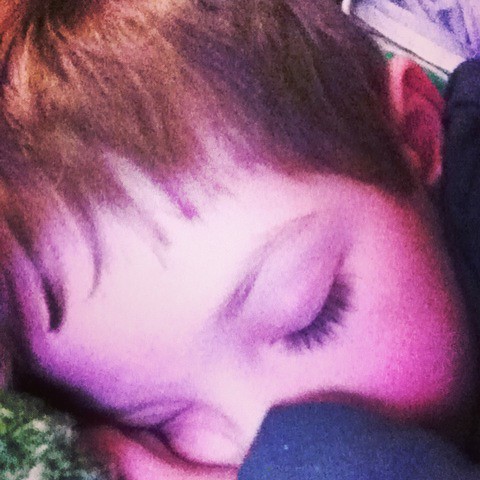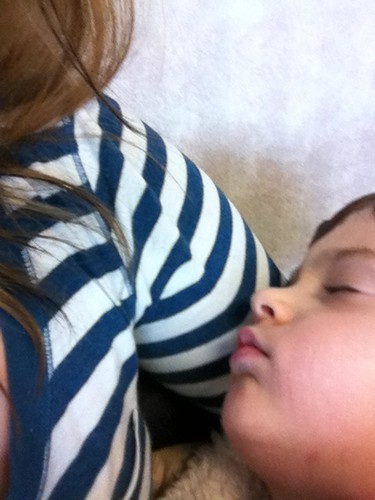Alternately titled, Sesamoiditis can suck it.
I thought I should write this post because in the last two and a half months, I've spent a lot of time googling bruised sesamoids and sesamoiditis and most of what I found was horribly depressing. People only write about worst case scenarios on the internet, have you noticed? And while my injury isn't all the way healed yet, it at least feels better enough that I feel the need to write something to balance out all the "I've had sesamoiditis for 6 years and had to stop running, THERE IS NO HOPE" posts that I found. If you're here because you're a regular reader of my blog, you can feel free to skip this post. Or you can read more to learn why I've had such crazy eyes over not running much lately. But if you're here because you googled sesamoiditis, hi. I'm sorry. Sesamoids are jerks, aren't they? Did you even know that they existed before you injured yours? I didn't. Granted, I'd sometimes wear heels and have a sore spot on the ball of my feet or run hill repeats and feel a little sore the next day, but ice and rest usually cleared it up.
And then I ran a half marathon with 50 mph wind gusts in shoes with a smaller than usual toe box. My gait was off, way off. I could feel it and kept correcting it, but it was impossible in the wind to keep it normal. I could feel my feet slapping the pavement and knew it wasn't good, but there wasn't anything I could. By the end of the half, the balls of my feet felt like I'd just walked across hot sand. Still, I figured that if I iced them all day at work the next day they'd be fine. Only they didn't get better, they got worse. The tricky thing was that it only hurt when I walked, not when I ran. I kept running moderately for about two weeks because I figured that if it wasn't hurting when I ran, everything had to be fine. In hindsight, I realize this is silly, but runners don't always think straight.
The frustrating thing was that I ran this half marathon in better shape than I'd always been. I trained for a PR. In the course of my training, I ran 13 miles twice. I ran a 14 miles once. I ran 15 miles. I was fine the day after each of these runs, but there were no wind gusts and I ran them in different shoes (before the half, I wore out the Brooks Adrenaline 11s that I'd always run in. The 12s didn't work for me because a seam caused a hot spot. I tried Mizunos and the high ankles rubbled my ankle bone. I finally settled on Nike Lunarglides, which seemed to work.). I expected that I would finish this half, take a day off to rest, then continue running faster than I'd ever run before and PRing more distances. I wasn't ready to give that up, so I was stubborn. Even with the wind gusts that day, I still PRd by 13 minutes. Two weeks after the half, though, I had to admit that it wasn't going to clear up on its own. The area over my sesamoids was visibly swollen. When I stepped down, a sharp pain shot up my foot. Every single time I stepped down, which I fondly referred to as the stabbing pain of doom. I couldn't even touch that area of my foot. If you're reading this and it sounds familiar, please call a podiatrist. It's not going to magically get better on its own. Trust me.
By some magical grace, my xrays showed no fracture or break, although one did show a shadow of an old injury or the start of a fracture. The doctor believed that it was the heavy wind and gait that led to the injury, although he mentioned that my feet have two things that can also contribute to sesamoiditis: high arches and a long second toe. So while it was the wind, my sesamoids are also more prone to injury because of the design of my feet. The doctor also mentioned that he really thought minimalist shoes would be more beneficial than stability shoes. I promptly ignored him because let's be honest here. My feet hurt so badly at this point that I wanted to wrap them in bubble wrap, tie pillows to the bottom and pay someone to carry me around. So the thought running in shoes with less cushion was not one that I could entertain at the time. He put me on anti-inflammatories, gave me a topical gel, instructed me to soak in hot water and epsom salts twice a day and told me that I could continue to run because there no sign of a break or fracture and because I told him it didn't hurt when I ran and I made an appointment to return in a week.
I kept running for a few days, then realized that although my feet didn't hurt when I ran and although everything I read was consistent with the doctor, I was tired of how badly they hurt the rest of the time, so I stopped running. This was hard. The anti-inflammatories helped the visible swelling, but they didn't help the pain any. After a week of rest, my sesamoids didn't feel any better, so my doctor did cortisone shots and fitted me for custom orthotics. I know there's a lot of controversy about whether or not cortisone shots are helpful or harmful, but I was willing to try. I will say that it was probably more painful than natural childbirth, which maybe someone could've warned me about?! His hope with the orthotics was that they would support my arches enough that some of the pressure would be removed from my sesamoids allowing them to heal. After another week of rest, plus the cortisone, my sesamoids felt better. Only, I managed to give myself plantar fasciitis from walking funny to take the weight off my sesamoids. That's funny, universe. After another week of rest, I saw my doctor to get the orthotics. He gave me instructions on how to break them in and told me when I would be able to run in them. I talked to him about the PF and he said that the orthotics should knock it out (and they did), but if they didn't, I needed to get in to see him right away. My feet are just a barrel of fun, basically. In anticipation of easing back into running, I'd bought new shoes, Brooks Adrenaline 13s. The reviews I'd read online said that they were much more like my beloved 11s than the 12s, so they were kind of my hope to be kind to my feet. Note that I was still ignoring the doctor.
After spending a few days breaking in the orthotics, I started running. Slowly. My 13s felt just like my 11s. Only my feet started to hurt again. I can't tell you how upsetting this was. I could feel it as I was running, could literally feel the pressure on my sesamoids when my feet would hit the pavement, even with the orthotics. I wanted to cry. I pictured myself clearing out my dresser full of running clothes and donating it to Goodwill because that was it. I was done. My feet weren't going to heal. Then I remembered what my doctor said about minimalist shoes. I started doing google searches. I learned that most stability shoes have a flex groove right beneath the sesamoid--sure enough, my shoes did. That's why I felt pressure when I ran, because a deeper flex groove leads to more forefoot flexion and more pressure in the area of the sesamoid. Exactly what I DIDN'T need and exactly what my doctor kept trying to tell me. Oops. I wasn't set to see my doctor for another two weeks and I didn't want to wait to discuss shoes with him, but I remember Dimity from
Another Mother Runner blogging about
Altra shoes before and how they were supposed to help with forefoot pain. A few google searches later and yes, they come highly recommended for people with sesamoiditis. I quibbled a little bit before ordering because man, my allegiance to stability shoes is hard to break, but I looked at my feet which were well on their way to stabbing pains of doom again and hit order on a pair of Altra Intuitions (bonus: they come in pink). I anxiously waited two days for them to arrive, then rushed home and took them out for a mile run. Because they're zero drop shoes, you do have to transition slowly into them. The site recommends switching off with your old shoes, but because my old shoes are hurting me, I haven't been doing that. Because my three weeks without running left me horribly out of shape (which is unfair because I've run for two years straight without any more than 2 consecutive rest days), taking it slow is no problem. What's great about the Altras is that they're foot shaped. The toe box is much bigger than a normal shoe, so it allows your toes to spread out. After two weeks in them, I can tell that my toes have naturally spread out. When my sesamoiditis was really bad, one of the things that relieved it was to pull my toes apart, so it makes sense that this would help. The bottom of the shoe maps the bones of the foot. No flexed grooves. No extra pressure on my sesamoids. My orthotics fit easily into the shoes, too, so I've been wearing them with the orthotics just fine. I've been slowly uppping my mileage to no extra pain, which is a huge relief.
I do still have some lingering pain and I imagine it'll be awhile before that finally leaves, but it's much better. I can press on the actual sesamoid bone to no pain. All I have left is soreness on the inside of my upper forefoot that I feel when I step down. That's it. I've been relieving that with kt tape, which I would recommend to anyone dealing with this. If you want to keep running on bruised sesamoids, this is a great way to deal with it. I apologize in advance for posting a picture of my feet on blog because feet are gross, but this is the best way I could explain.

First, wrap kt tape *tight* around your upper forefoot. I wrap all the way around to make sure it's tight and stays in place. Then take the second piece and run it down the side of your foot. This doesn't need to be as tight, but make sure it covers the sesamoid, too. This is the best way that I've found to relieve the pain. Moleskin works, too, but I don't think that it promotes healing as well as kt tape.
There's a whole lot of hindsight in this post. If only I'd run my half marathon in shoes with a wider toebox. If only I'd run my half marathon on a day without insane wind gusts. If only I'd gone to the doctor sooner. If only I'd not been so stubborn and LISTENED to the doctor sooner, but in writing this, I hope that I can help someone. Even if you don't have sesamoiditis but you're considering making a shoe switch, I would really encourage you to check out Altras. They're great shoes. I obviously never thought I'd be singing the praises of zero drop shoes, but well. Here I am. I explained to a friend that stability shoes worked really well for pre-injury me, but they workedh horribly for post-injury me. If only I'd admitted to that sooner! I'm hoping that someday soon, I can come back and tell you about how my feet don't hurt AT ALL. That would be really wonderful.












